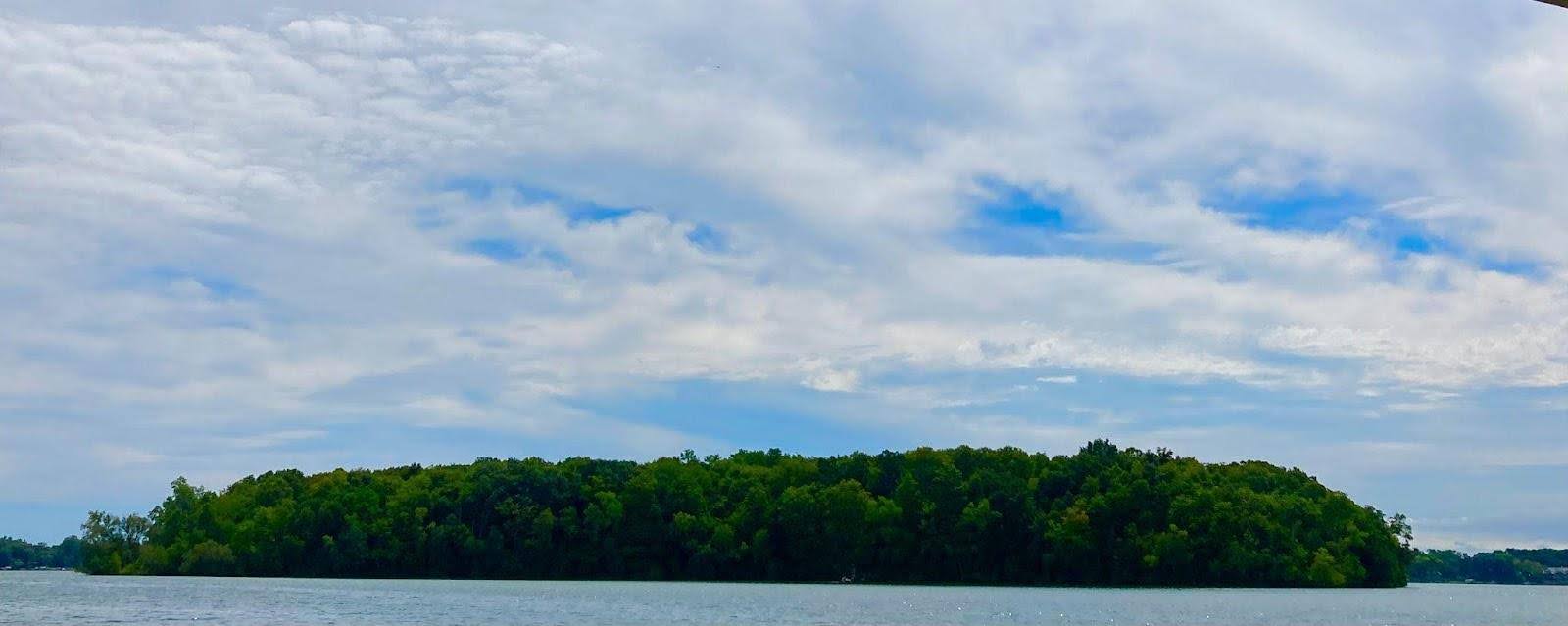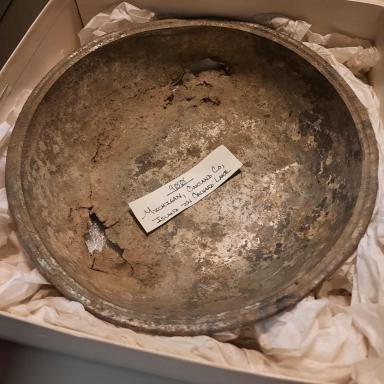The challenge posed to students about a local island and its indigenous past is sparking a new level of student engagement and ownership of their learning. This real-life problem led to the adoption of indigenous course texts, which in turn is deepening student understanding of the original problem and beyond.

Whoa! What a ride. Since I first embarked on my “problem of practice” in March of 2024, so much has changed. I could not have predicted a year ago that researching ideas to diversify the ELA curriculum would no longer be legal under our new presidential administration. Here, then, is an account of my work over the last two years; it is my hope that novice teachers and administrators will find this both inspiring and useful in their respective roles.
I felt compelled to make this my focus because of place-based curriculum work my students and I engaged in during the 2023–2024 school year. My district owns Apple Island, a 35 acre uninhabited island in the middle of Orchard Lake. The last owner of the island, also known as the Marjorie Ward Strong Woodland Sanctuary, donated it to the West Bloomfield School District to preserve it “in its natural state as a permanent woodland sanctuary, that the children of this favored land of lakes and forest may, as young students, learn to cherish, understand, and guard the priceless gifts of nature” (Greater West Bloomfield Historical Society). In August of 2023, a group of six educators, three secondary and three elementary, began working on place-based educational ideas for students at both levels.
As the secondary English teacher in the group, I began researching the island to think about what materials I could offer to students who would be visiting the island for field trips in the spring of 2024. In the course of that research, my Points of View seniors and I discovered that Indigenous artifacts had been found during archaeological digs in 2008 and 2013. However, in their 2018 National Register of Historic Places application, the author(s) note: “While the evidence of the Native American occupation of Apple Island indicates significant research potential, a National Register nomination is not being pursued at this time since the site boundaries are not clearly defined. These sites are considered non-contributing elements to this nomination since they are not associated with the Campbell occupation of Apple Island.” We found this curious, since further research uncovered first and second hand accounts of Indigenous activity there, including descriptions by Caroline E. Campbell, a summer resident of Apple Island:
The island seems to have been a favorite burial place for the Indians.
When Mr. John Coates sold the island to my father, he took with him a
fine collection of Indian relics, which' are still, I believe, in the museum
in Paisley, Scotland. Among these was quite a large silver cross, which
was taken, supposedly, from the grave of a chief. This shows that the
Jesuit Missionaries had been among our Indians. We have very few relics,
but I am sure the uncultivated land would contain great numbers. The
little hills on the south shore of the island seem to many to be burial mounds.
However, I should be the last person in the world to disturb the Indians' quiet
sleep.
A note: we reached out to the Paisley Museum in Scotland, which did not respond. The Greater West Bloomfield Historical Society (GWBHS), which maintains the Apple Island collection at our local museum, also said they had been unable to confirm this account.
Campbell continues,
About 1885, the caretaker on the island was plowing and pierced
a small mound. Here was seated a skeleton with a pewter pan in his
lap, the pan filled with wampum. It also contained a knife, rusted
almost beyond recognition. The plow share went through the pan,
but I still have it, although someone unkindly robbed me of the wampum.
There was a great deal of it, so this skeleton had probably been a chief.
In 1908 or 1909 another man was ploughing in a field that had long been
cultivated. The earth must have gradually washed away so that the level
had been lowered, for he pierced a grave containing two skeletons lying
on their faces…Had I known of any scholars who would have desired to study them,
I should have been glad to have had some light thrown on the subject;
but knowing none, I had them covered again without disturbing their
bones any more than possible, and I felt how strange it was that we
could get no answers to our question as to who they were, why they
lay there, or indeed to any of the real history of the countryside.

These stories intrigued my student scholars and me. Was it possible that Indigenous ancestors of a local tribe still lay beneath the island’s surface terrain, robbed of their burial items? One hundred years later, and we had some of the same questions as Ms. Campbell herself.
Mindful that history contains many stories, my students were eager to expand on the Indigenous materials available to the public by working with the GWBHS. My students researched extensively, calling and emailing tribal officials, professors, archaeologists, historians, and the like. Since a field trip to Apple Island is a staple for our elementary school students, my seniors sought to create a children’s book, with fact checking by the tribe and others, to update the current curricular materials. A visit to Apple Island in May 2024 with Dr. Andrea Knutson of Oakland University raised the possibility that the island may have been used as a rich food source for Indigenous peoples. It also laid bare the extent of trespassing and trash—including an extensive amount of broken glass on pathways—that my students cleaned up, keenly aware of small children and tripping hazards. (My students have a laundry list of research topics, including ongoing legal and environmental questions!) While we didn’t complete everything my students had aspired to, the seniors graduated with a sense of accomplishment, knowing that I could pass the torch to my incoming students in the fall of 2024.
I also requested pilot materials for my American literature classrooms: Angeline Boulley’s Warrior Girl Unearthed and Monique Gray Smith’s adaptation of Robin Wall Kimmerer’s Braiding Sweetgrass for Young Adults. To my delight, our place-based grant provided the fund for these materials, and this past fall, I introduced my students to different ideas regarding Indigenous culture, concerns, and celebrations. We wrestled with difficult questions: did the school district have any duty of care as defined by the Native American Graves and Repatriation Act (NAGPRA) to return items to the tribe? Should we write a land acknowledgement agreement? How should we create updated materials, and were there other tribes that should be consulted? How could we access more research materials on Apple Island given the limited hours of the GWBHS?

Most of all, my students asked me over and over again, did we even belong on the island at all? Was it a sacred place?
Compounding these knotty real-world questions were a host of equally perplexing concerns. In the fall of 2024, the new boats the district had purchased to ferry students out to the island broke down, meaning that my new students and I could not visit the island until May 2025 at the earliest. The small staff (and physical size!) of the GWBHS Museum was swamped with artifacts from the closure of Roosevelt Elementary, the oldest school in the district. At the same time, central administration—with a small group of English teachers—began the arduous process of reviewing new resources to update our old textbooks. Our place-based education committee work was not well-known around the district. It was also difficult to get in touch with the tribe; communication has been intermittent owing to their small administrative team.
In spite of these challenges, we have had so many successes. In December, two of my sophomores, after reading Warrior Girl Unearthed, wrote—and won!—a grant to obtain funds to pay tribal officials for their time and expertise in reviewing the children’s book they hoped to complete. Last May, my seniors filled out curricular review forms for our district recommending that two of Boulley’s novels and Braiding Sweetgrass for Young Adults be added to our American literature curriculum. One team noted that Warrior Girl Unearthed “is told from the perspective of an Ojibway woman, who partakes in Ojibway practices, that lives in Michigan. Students will be heavily exposed to a culture, language, and traditions that are often overlooked in the classroom in a manner similar to that of many of the diverse students at West Bloomfield.” These were not cliched five paragraph essays—in both cases, students wrote with deep conviction in real world opportunities after exposure to concerns facing residents of our state.
In March we received word that district officials are working with the GWBHS to deliver all of the Apple Island materials, including artifacts, to the high school for students to create a museum highlighting the history and importance of the island. This will allow students to work with more professionals around the state in a concrete, real world opportunity to build a museum within their high school from scratch. It also allows our three teachers—in English, history, and art—to bring students together for a tangible, intersectional, living project that will need to be updated throughout the years as more information becomes available. This has the potential to be place-based and project-based learning at its finest. Had we thrown up our hands in defeat with the competing interests of all of the various stakeholders in this project, students would never have had the opportunities we now have within our grasp.
This May, my sophomores will visit Apple Island for the first time since reading their Indigenous texts. Who knows what will spark in their brains and hearts after all of this work? Yes, the many stops and starts have been frustrating, even maddening at times. It has required me to pivot, to release my ego, to let go of my own visions for this project, to share power with so many interested parties. I had to, as my mentor Kendra puts it, “go with the willing,” time and time again. I know it was all worth it, though, when I read the reflections my students wrote on how their empathy for others has expanded as a result of reading these and other texts. It hasn’t really mattered whether the text was Angeline Boulley’s Warrior Girl Unearthed or F. Scott Fitzgerald’s canonical The Great Gatsby—I am always trying to challenge my students to think about what voices are represented, and which voices are silenced or missing, and why. This is the kind of critical thinking that will serve my students long past our time in the classroom; the kind of critical thinking demonstrated best by my two grant writers and their hopes for their Apple Island children’s book, a book they don’t even have to write:
This new story will impact the younger generations, but it will also act as an informative guide for our community on the rich history of Apple Island and the actions we can take to preserve the land we love. From kid to kid, we believe that this story, which would be researched, written & illustrated by our own hands, will challenge the idea that history in our past doesn't affect us in our present.
